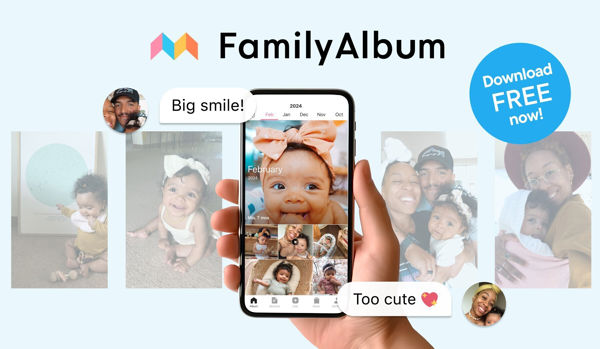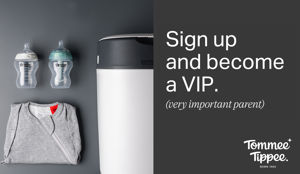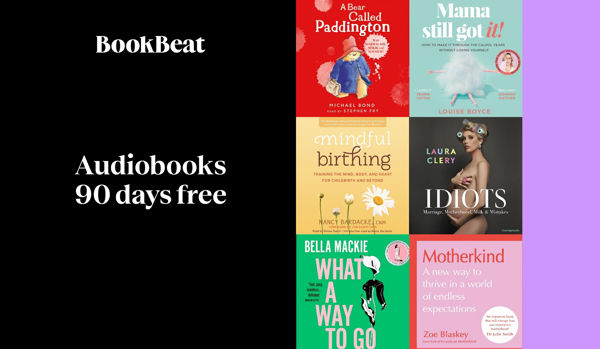Congratulations, you’ve made it! Your bundle of joy has arrived, and now the hard work starts. Having a baby, whether it’s your first or your third, can be challenging so we’ve put together a great guide at what to expect at every stage of your baby’s growth. Please remember though that is just a general guide and all babies develop differently. If you are concerned about anything to do with your baby’s health or progress, please seek advice from a professional.
After the birth
If you’ve seen newborn babies on TV or in films, you’d be forgiven that they are born all nice and clean and a lovely shade of pale pink. In real life (and on One Born Every Minute), your newborn is likely to be a bit wrinkled and more purple than pink. They might have a waxy yellowy substance called vernix on their body or some residue from the actual birth. They are also likely to be quite hairy! This hair is called lanugo and helps to protect your baby in the womb. It will fall out quite quickly, and the hair on their head at birth might disappear too. You may notice that your baby’s skull is squashed or has a strange shape from the birth, this shape may change during the first few days or weeks. Their legs may also be squashed up into the same position they were in your tummy, but they will soon stretch them out. Your baby may be taken to the side of the room or theatre to be cleaned slightly if they have meconium on them (basically this is when they do a poo inside the womb)
You’ll be offered skin to skin contact within about an hour of the birth and you can do this even if you have had a caesarean section. It may be the case that your partner is offered the chance to hold the baby against their skin too, as that helps with their bonding.
[Read more: The Importance of Skin to Skin Contact]
You will be encouraged to breastfeed your baby but there is absolutely no pressure to do this. There are other ways that you can help your baby to feed on your milk, especially their first feed with the all-important colostrum. Your midwife and the other staff at the hospital will help you with whatever you need so you don’t need to be afraid to ask. Your baby will want to feed roughly eight times in 24 hours, but this may not be evenly spread!
There are a number of tests carried out on your baby after their birth, but none of them is painful and your baby definitely won’t remember them! The first is the Apgar test which is done at one minute and five minutes after the birth, and possibly at ten minutes. Your baby will be given a score of 0-10 for breathing, responses, heartbeat, colour and muscle tone. The majority of babies will score between 7 and 10.
The midwife or doctor will also measure their weight, length, head circumference and temperature after delivery. Before you are discharged a full examination of your baby also takes place, checking their organs, bottom, hips, eyes, heart and genitals. There may be additional tests required such as if your baby was breech at birth or if the doctor suspects your baby has jaundice. Again these tests are routine and nothing to be concerned about.
Going home
Taking your baby home can be both exciting and daunting, but you’ll feel much more relaxed when you’re back in your own surroundings.
Your milk will come in after about three days and your baby is likely to continue with the eight feeds in a daily routine. They will sleep for around 18 hours every 24 hours, but this could be coupled with plenty of wake-ups. They won’t know the difference between night and day yet so expect some broken sleep at night-time.
If your baby has their umbilical cord stump clamped, try to keep the area around it as clean as possible. Cotton wool and water is the best option for this. You can leave the clamp on safely until it dries and falls off, but have a look daily for any signs of soreness or infection. Your midwife and health visitor will check this as well.
Giving your baby a full bath isn’t necessary at this stage but make sure that you give them a ‘top and tail wash’ each day.
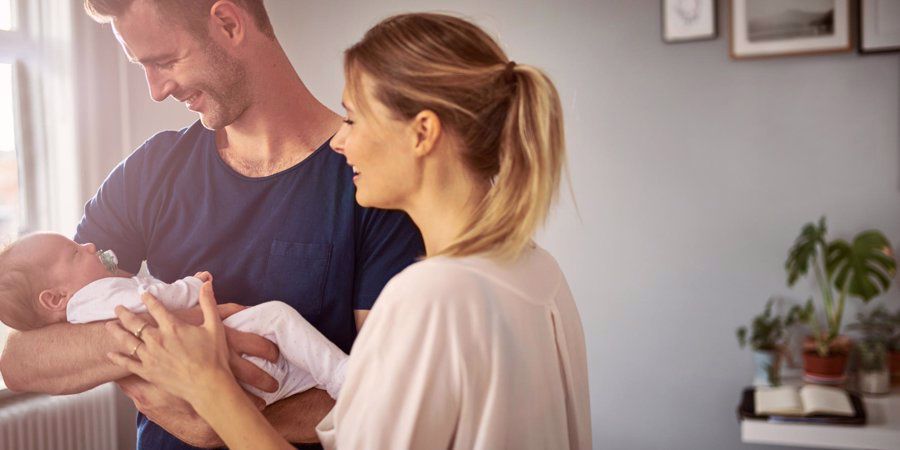
One week old
Your baby is already developing quickly at one week old. They will be able to recognise yours and your partners’ voices and smells and can see roughly 25 cm in front of them. They might try to copy your facial expressions, such as sticking your tongue out.
They will be able to hold on to your finger if you put it in their palm, and start showing strong sucking reflexes. You may notice that they start rooting on your chest for food or open their mouth if you stroke their cheek. If you can, try to understand what your baby’s hungry cues are. These are the movements they make to show you that they’re hungry.
Your midwife will visit in the first few days to check your baby over and take certain measurements. It is very common for newborns to lose weight in the first few days or develop jaundice, so make sure they are feeding often and getting access to sunlight. Your baby will have a heel prick test, which is a very small blood sample taken to test for sickle cell disease, thyroid deficiencies, cystic fibrosis and other medical conditions. The results for this will come through very quickly.
[Read more: Sleep Safety Guidelines for Babies]
At two weeks
Although it may not seem that your baby’s eyes are focusing, they can see things that are up close to them, especially bold shapes and black and white colours.
You will probably still be establishing a feeding routine/schedule so your newborn may still be losing weight, but you can discuss this with your midwife or health visitor if you are concerned. They will ask you about the number of wet and dirty nappies your baby has each day, and look at their colour and level of alertness. Once your baby starts putting on weight, they will gain an average of 25g per day.
[Read more: Identifying Colic and How to Soothe Your Baby]
You may notice that their nails need cutting by this point, the easiest option is to wait until your baby is sleeping before you attempt a trim! If you do cut too much or there is a little blood, you’ll be more upset than your baby is and it will heal up very quickly.
At three weeks old
At three weeks old, your baby will be looking more stretched out than at birth and their skin will be less wrinkled and plumper. They might be sleeping a bit less than the first few days, and now is a good day to try and introduce the distinction between night and day. Don’t try and force it by keeping your baby awake for long stretches though. You are likely to still be doing at least one-night feed, if not many more.
You will notice that the amount (and level) of crying increases and the cause may not always be obvious. Try to work through one thing at a time – check their nappy, are they tired, are they hungry, are they bored?
If your baby seems uncomfortable after feeding, they may be suffering from colic or reflux, or have an intolerance to the milk. Check with your health visitor for advice on how to help your baby with this, for many babies, these are issues which only last a few weeks.
[Read more: Breastfeeding 101]
At four weeks
This is a really exciting time as your baby will find their own hands and feet, normally by accident! They won’t realise that they belong to themselves at this point though, but they are a fun new toy to play with.
Also at four weeks, your baby’s hearing will have developed fully and you may see them jumping or turning their heads towards a loud sound. Your baby may start trying to follow an object with its eyes as it moves closer to them.
Now is a good time to start some ‘tummy time’ to encourage your baby to lift their head and build on their arm muscles. At four weeks your baby may try to turn their head from side to side but you will still need to provide plenty of support.
[Read more: Why I Adopted a Dairy-Free Diet Whilst Breastfeeding]
At one month
Your baby’s development will pick up massively once they reach one month old. You will probably hear them making noises like gurgles and grunts and they will be even more receptive to sounds. Now is the time to start ‘talking’ back to them in a baby or sing-song voice, as it's brilliant for their development. Even if you’re just describing what you’re doing, it all helps.
Your baby will discover their arms and legs and maybe waving them around a lot, their co-ordination comes later on. Their neck strength will be increasing and they may be able to hold their head up for a brief second.
[Read more: Breast Vs Bottle]
At two months
Now the fun really starts! Your baby will smile at you for the first time and will be able to see items that are further away from them. They will still respond better to bright and bold patterns and colours and you can encourage this with toys or fabric books.
Your baby may be able to recognise familiar voices, especially those of close family members, and songs. Look for their response to songs or noises they may have heard in the womb!
The arm and leg kicking that your baby loves to do will become slightly smoother in its action and they might start waving their hands and feet around. They may start showing signs of wanting to roll, so take care if you have them up high for nappy changes.
If you have long hair or wear glasses you may find that your baby reaches for them, and doesn’t let go. This is because their grasping reflex is not fully developed yet.
Although you are a few months away from teething you may see your baby start to drool, as they begin to produce more saliva. Make sure your baby has a bib or cloth around to mop it up, as it can cause soreness on their skin.
Your baby may be sleeping in longer blocks, hopefully at night, but this is definitely not the case for everyone!
You will be asked to book in for a six-week check-up at your GP surgery, and this is a check-up for both you and the baby. Your GP will take measurements of your baby and check certain things such as reflexes and feeding. They may talk to you about contraception and any mental health issues you may be experiencing. Be completely honest and don’t be afraid to ask for help if you need it.
At around eight weeks you will be offered the first set of vaccinations for your baby. Get in touch your health visitor or GP surgery if you haven’t been contacted. The first jabs immunise against the following:
- Rotavirus – a nasty virus that is very contagious and can cause gastroenteritis
- DTaP/IPV/Hib – this one vaccinates against diphtheria, tetanus, hepatitis, whooping cough, polio and Haemophilus influenza
- Pneumococcal Conjugate Vaccine (PCV) – this is for pneumococcal infections such as pneumonia and bronchitis
- Meningitis B – this protects against only the meningitis B strain
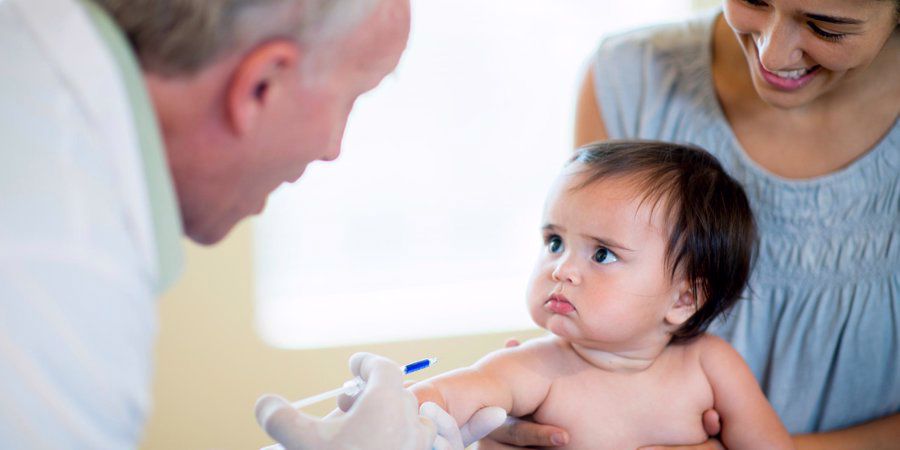
At three months
Now that your baby has more control of their hands and feet, they may try to get them in their mouth, usually unsuccessfully. They will also respond more to different textures and materials. They may be able to accurately hit an object in front of them, such as a toy dangling on a bouncer or mobile. Their arm and leg movements will be gaining in co-ordination and their joints will be strengthening.
You will see your baby smile a lot more and they will be fascinated by other people, especially other children and their own reflection.
At twelve weeks it’s time for the next round of vaccinations, which will include the second doses of the rotavirus and DtaP/IPV/Hib jabs.
[Read more: 3 Foods to Cut Out When Breastfeeding]
At four months
Your baby’s senses will be developing rapidly by four months and you will notice that they will test out new things by putting them in their mouth. This will include anything that they can get their hands on, including you and your clothes! Ensure that there are no small or dangerous items within reach at all times and think about your own jewellery and clothing.
Your baby will begin to see the differences between colours now, so you can introduce paler colours and more complex patterns. If you have any concerns about your child’s sight, even at such a young age, talk to your health visitor and they can advise on getting it checked.
You may hear the start of some letter sounds coming from your baby, and they will make different sounds for different emotions. They may start to imitate noises that you make too.
Some babies can roll over at four months, either fully or partially, and may start to make a ‘skydive’ type pose when they’re on their tummy. This is a great sign that their muscles are developing, particularly in their back and neck. You should still provide adequate support for their head at this age, as they may not be able to hold it independently for long periods of time.
Teething starts between three and twelve months old although you might not see the first tooth pop through for a few weeks. Some common signs of teething are excess dribbling, red gums and chewing on their fist or fingers.
You may find that the number of feeds that your baby wants decreases by month four. This is nothing to worry about as your baby will be taking on more milk at each feed. If you are worried, keep a diary of the amounts and times of each feed and talk to your health visitor.
At sixteen weeks you will need to attend for your last set of immunisations until your baby is one. This round includes second doses of Meningitis B and Pneumococcal, and the third dose of DTaP/IPV/Hib.
At five months
Your first hug from your baby comes at around five months and they will also be holding their arms up, wanting to be picked up. Their focus will be more developed and they will be able to follow a slowly moving object more easily. They may cry when you move something or they can’t see it any more. This is because they have no awareness that objects still exist even when they are out of sight.
Your baby will be rolling more and may also be able to sit up for a time if they are supported with cushions or in a baby chair. You’ll find that they do fall sideways easily though.
You may hear their first laugh and the range of sounds that they have will increase, especially in response to funny faces or smiles.
When it comes to sleeping, some babies will be sleeping for a 5 or six-hour stretch a night at five months old but there is nothing wrong with your baby if they are not doing this. They may have reduced their daytime naps too. Check your baby’s sleeping across a whole 24 hour period, if they are sleeping too much or too little in the daytime it could be impacting on their nighttime sleep. Also, look at their bedtime routine to ensure that your baby understands when it is time for their longest sleep.
At six months
When your baby reaches six months you will see a number of major changes in their development and your life too.
You can start weaning your baby from six months, which is the guideline age from the World Health Organisation. Before this point, breastmilk or formula is enough nutrition for them and should still form a part of their diet until at least twelve months.
[Read more: When To Start Weaning]
You can also expand the types of sensory and other activities you do with your baby. They will be able to focus on smaller details now, such as an intricate pattern or your earrings.
Your baby will be moving around more and more and may start crawling from six months, although many babies crawl from eight or nine months. You will see your baby try to make the movements they need to be able to crawl so try to leave them to figure it out themselves, however frustrating it may be. Tummy time is still great at six months for building muscle strength in their arms and legs.
You may notice that your baby is expressing preference towards certain people at this age, and becoming upset when being held by others. This is very normal and may continue for a few months. Try not to play up to these preferences, and demonstrate to your baby that they are safe with others and that you are never far away.
[Read more: Food Allergies in Babies and Young Children]
Development anxiety
As a parent, and especially for first-time parents, you may be concerned that your baby is not keeping up with the expected development for their age. This is not helped by friends or family members offering ‘helpful’ advice.
Keep in mind that all babies develop at their own speed and differing abilities. There is no correlation between the age that your baby started to crawl and their achievements in adult life. Try not to make comparisons to other babies, and you won’t win any favours by bragging about your baby! Even siblings will develop at different times so don’t assume that your baby will follow the same timeline.
If you do have any concerns, talk to your health visitor, midwife or GP and don’t be tempted to research online.
[Read more: Your Baby's Development - 6 to 18 Months]


